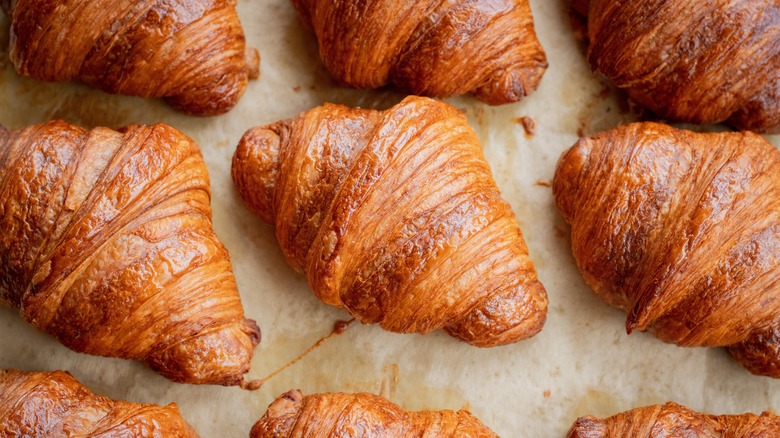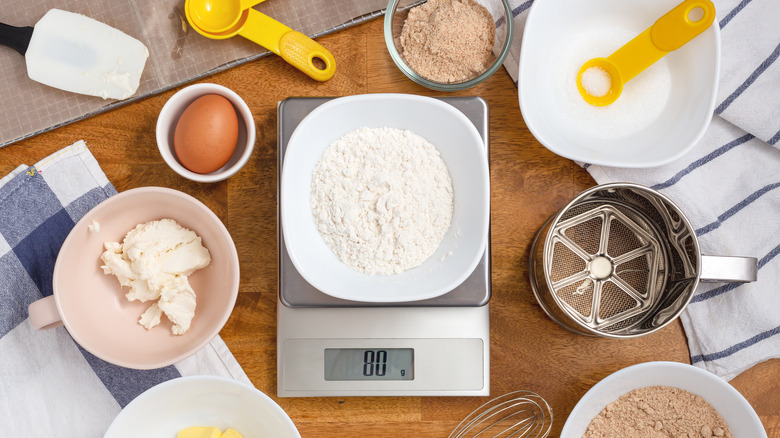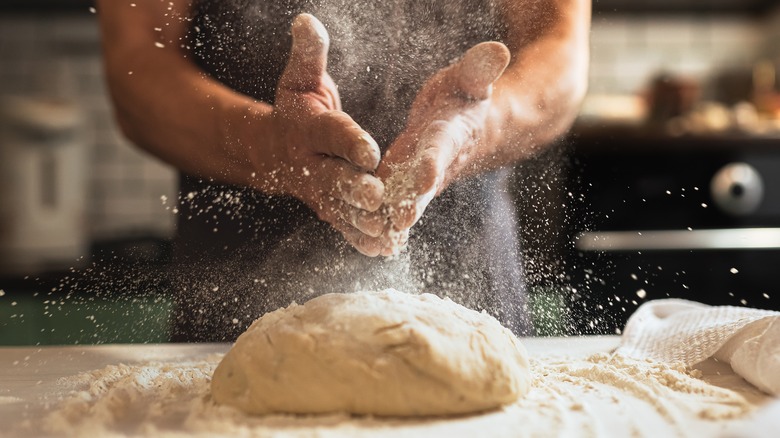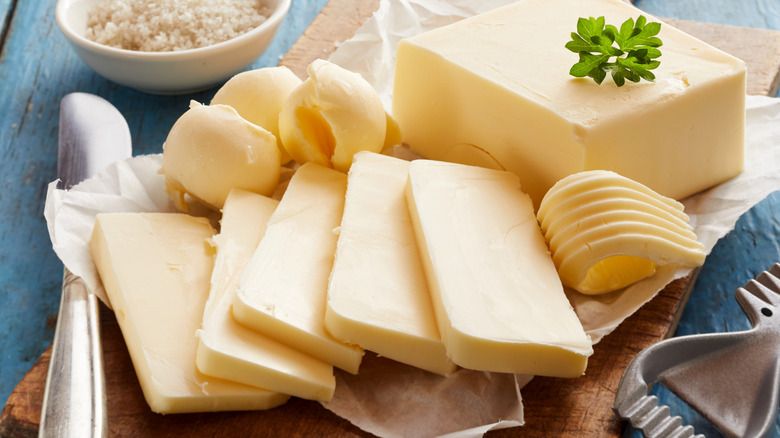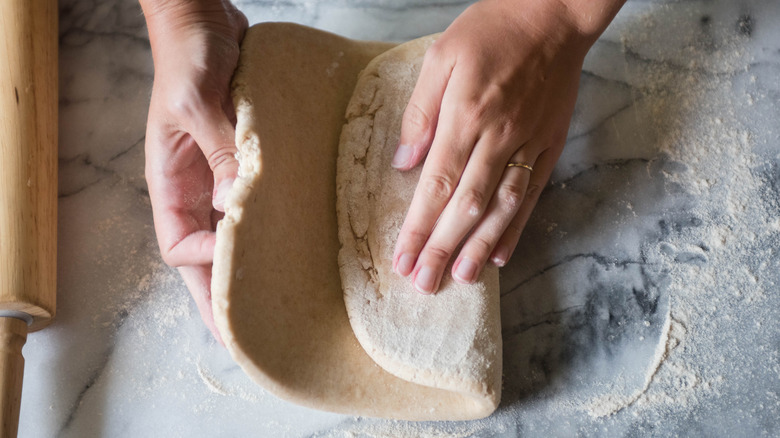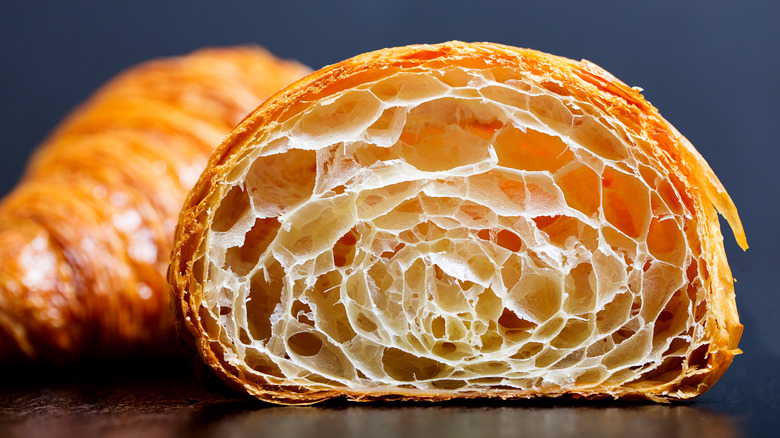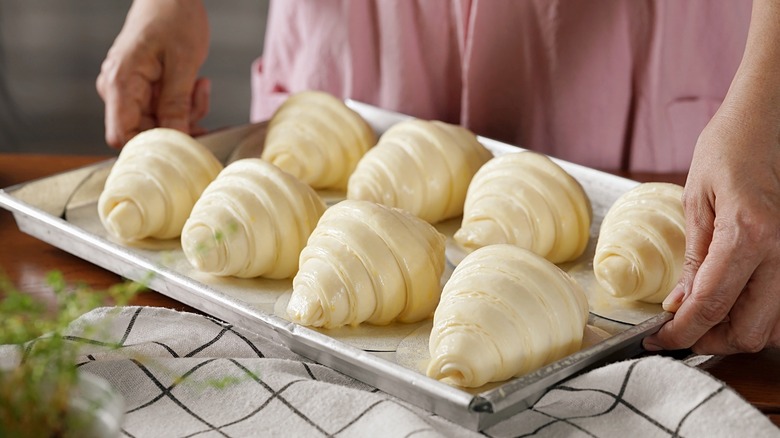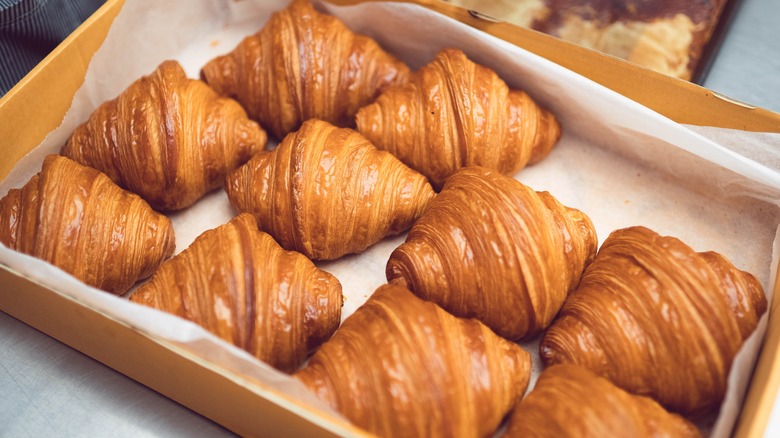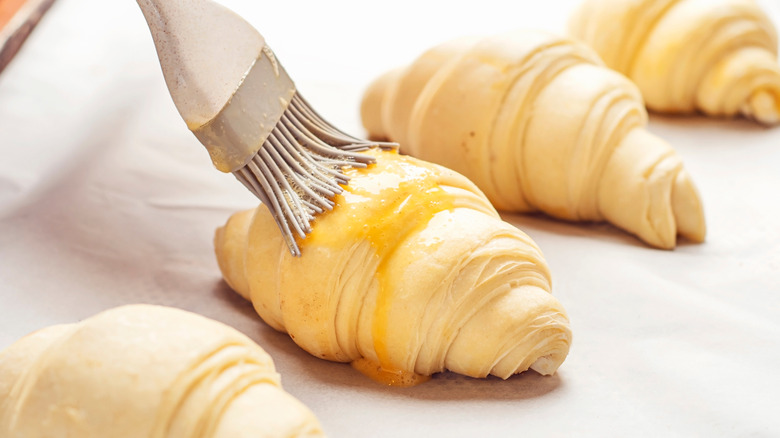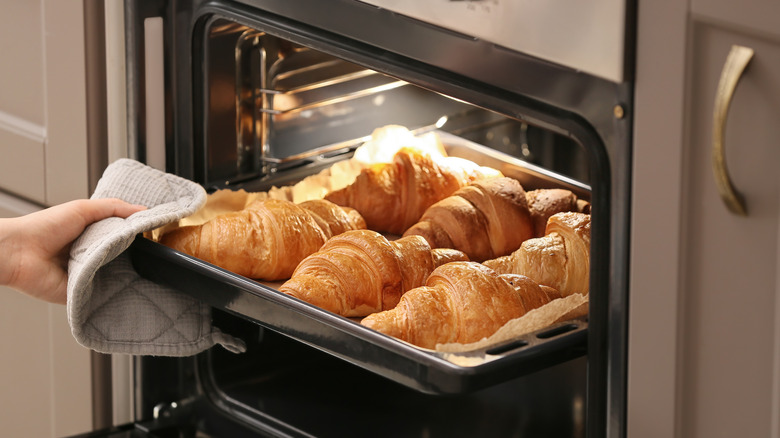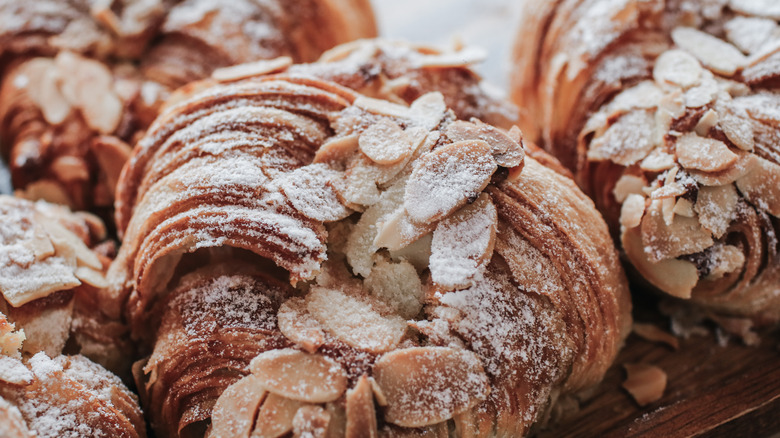The 12 Biggest Mistakes You're Making With Croissants
France is famous for many things: the Eiffel tower, fashion, Champagne, macarons, and, of course, croissants. Although we know it as an iconic French pastry, the croissant may have origins in the Austrian kipfel, which, much like the croissant, is served for breakfast with coffee. No matter their genesis, croissants dominate boulangerie sales across France and have even spurred the creation of new treats like Dominique Ansel's cronuts.
Sampling a freshly baked, flaky, buttery, rich, and layered pastry is a requirement when visiting France. We wouldn't be surprised if it's a bucket-list item for many people. But what are you to do when not in France? When there is no boulangerie in sight? Bake your own, of course!
When tackling an extremely challenging bake like croissants, advice from an expert in the field is invaluable. That's why we've collaborated with Aux Pains de Papy, a quaint French bakery in the heart of London. The bakery has been in operation since 1948 and has a rich heritage of serving freshly baked traditional pastries to locals and travelers coming into London from Kings Cross Station. The croissants, in particular, are legendary; Aux Pains de Papy serves croissant au beurre (butter croissants), croissant aux amandes (almond croissants), and pain au chocolat (chocolate pastry), amongst others. So, without further ado, let's dive into the most common mistakes you're likely to run into when making croissants and how to avoid them.
Not following the recipe
Baking is a precise science; elaborate and multi-stage recipes like croissants are prone to mishaps if you change the procedure in even the slightest of ways. For this reason, chef at Aux Pains de Papy and finalist of "Bake Off: The Professionals" (2020), Ryan Pinheiro, made a point to emphasize that one of the biggest and easily avoidable mistakes he observes is people not following the recipe.
Instead, Pinheiro says you should find a detailed and comprehensive croissant recipe and stick to it. Read through each stage of the recipe carefully, ensuring you understand each step before you begin baking — not just how to follow the instructions but also why each stage is vital. Pay particularly close attention to timings, temperatures, and measurements. Don't make any adjustments, even if temptation arises. Trust the experts.
Making croissants is a lengthy process that generally requires resting and chilling the dough for hours. This example is another prime reason we recommend running over your recipe beforehand and analyzing how much time to set aside instead of being unpleasantly surprised. Numerous croissant recipes even demand overnight or multi-day undertakings.
Using cups instead of scales
There's one significant difference between European bakers and American bakers. Can you guess what it is? That's right — in North America, it's standard practice to use cups while cooking. We know this might ruffle a few feathers, but there are a few good reasons why you may want to switch to using a scale when baking. First and foremost, according to The Washington Post, your measuring cups are just not accurate enough for precise recipes like croissants. The publication found that a 6% variation between measuring cups and scales isn't unusual; that magnitude of inconsistency can be tremendously detrimental to your baking.
What about the "scoop and flatten" method? We hear you — while it's unequivocally better than under or over-packing your cups, as Marsden Weighing points out, weight measurements will always be more accurate than volume. Furthermore, there is considerably more room for user error with measuring cups. Think about it: How many times have you lost count of how many cups you were supposed to add to that cake?
If we've done our job persuading you, now is the perfect opportunity to invest in a high-tech baking scale with incredible accuracy. A measuring scale will revolutionize your cooking and make complex recipes like croissants less unpredictable, eliminating discrepancies down to one-tenth of a gram.
Not letting the dough rest for enough time
We completely understand the adrenaline rush experienced when baking. Okay, it's not quite skydiving or mountaineering, but an undeniable eagerness to get your pastries out of the oven and into your mouth as soon as possible takes over. However, croissants necessitate patience first and foremost: It's so critical, in fact, that Jacques Torres names it as his number one secret to the perfect croissant.
After you've formed your dough, you need to let it rest at a low temperature (in the refrigerator is ideal). Chef Ryan Pinheiro recommends resting the dough for at least eight hours, although most home cooks may find resting the dough overnight more convenient. The chef eexplains that the water and yeast in the dough must completely dry out. If you rush this stage, the croissant may be dense and heavy rather than the desired outcome of deliciously light and airy.
A kitchen that's too hot or cold
How temperature influences the success (or failure) of your croissants is perhaps the most important nugget of information the bakers at Aux Pains de Papy shared with us. Notably, allowing your laminated dough to reach room temperature can ruin your puff pastry as it causes the butter to melt, resulting in the dough losing its shape and the distinct layers you worked hard to build. Most recipes suggest chilling your dough after each fold or "turn" to ensure the temperature doesn't rise. Chef Ryan Pinheiro agrees, telling us that he lets the dough rest for at least one hour each time — this helps to rest the gluten and also controls the temperature.
Unfortunately, a kitchen that is too cold presents its unique problems. Pinheiro warns that chilled dough can be hard to work with, resulting in the pastry being too stiff to fold or even tearing. Similarly, when the butter is considerably colder than the dough encasing it, it can tear or take on a "speckled" effect from unevenly distributed butter. The solution is to use good quality butter, beat it to a pliable consistency, and control the temperature.
Ultimately, it's paramount to achieve a balanced temperature in your workspace and use instinct when assessing the dough. The seasons plus your country's climate and humidity will affect the ambient temperature in your kitchen, so it's a good idea to be aware of this ahead of time and plan accordingly.
Using standard butter
Aux Pains de Papy exclusively imports the finest quality produce straight from France. This decision isn't a matter of elitism; it makes all the difference between a croissant tasting rich, buttery, and subtly creamy or feeling fatty, cheap, and artificial. Hunt for the best butter you can find; it not only supplies the predominant flavor of the croissant but also directly contributes to the distinctively flaky, layered texture.
Not all butter is made equal. American and European butter are often different due to the fat content. While the U.S. Department of Agriculture mandates that butter should be at least 80% butterfat, European butter contains upwards of 82-86% butterfat, per The Washington Post. What does this mean? More butterfat directly equates to less water, resulting in an intensely creamy, more desirable flavor. European butter is also produced differently, with more artisan brands following the traditional hand-churned methods.
According to The New York Times, one of the most sought-after kinds of butter by top chefs, beurre d'Echire, is intensely regulated. The cows must graze on a rich, fertile patch of land no more than 19 miles from Echire, as the milk takes on a delicate grassy flavor. Most importantly, the cream is cultured before being made into butter, resulting in a distinctive yet subtle tangy taste. The ensuing butter has a higher melting point, making it prized for pastries like croissants. In short: Use European butter for pastries. You won't regret it.
Handling the dough too much while laminating
First, let's address the most important question: What is laminated dough? It's the process of adding a sheet of butter between a layer of dough, folding, rolling, and repeating the process to create a rich, fatty, layered pastry. This dough is responsible for beautifully delicate, flaky, and layered croissants. There are two types of laminated dough: unleavened (such as phyllo and puff pastry) and leavened, meaning to use yeast, such as croissants. Another vital difference between puff pastry and croissant dough is the density, with croissants exhibiting a tender crumb.
One of the primary mistakes beginners make with laminated pastry is handling the dough too much. Often done out of nervousness, lack of confidence, and an urge for perfectionism (perfectly square pastry sheets, we're looking at you), it's one of the most destructive mistakes and responsible for textural issues. Over-handling the dough causes the heat from your hands to break down the butter layer, so it absorbs into the pastry. As a result, instead of precise, magnificently distinct layers, the dough will become more dense and chewy, with a bread-like crumb.
Additionally, a deft yet gentle touch is vital. Applying uneven pressure when rolling, shaping, or pressing the dough, along with accidental dents and fingerprints, has the potential to ruin the carefully formed croissant layers. Although it's natural to be somewhat nervous when working with croissant dough for the first time, remember to handle the dough delicately, work swiftly, and above all else, practice.
Making too few or too many folds
Bakers working with laminated dough have a crucial decision — specifically, which lamination method to use and how many folds to create. There are two principal ways to fold the laminated dough: a letter fold (also known as a tri-fold) or a book fold. The former involves shaping your butter to be ⅔ the size of your dough, placing it on one end of the dough, and then folding the dough in thirds, much like you would fold a letter before placing it in an envelope. When repeated, this method multiples the previous number of layers by three, meaning that after just a few folds, you'll achieve exponentially more layers with minimal work.
The second method, the book fold, has four layers. Take your butter block and place it in the center of your dough, then fold both sides of the dough towards the middle. Finally, fold the dough in half along the center line, as if you're closing a large book. As King Arthur Baking points out, more folds don't always mean better croissants; conversely, croissants with fewer folds have a desirable "honeycomb" texture. For this reason, we suggest you reserve the more layered book fold for other bakes, like Danish pastries. Most recipes require a combination of folds (or "turns," the technical name), typically starting with a French single-fold (simply folding the dough over the butter once to "lock in"), followed by three letter-folds, to build up the layers.
Under or over-proofing the croissants
Croissants are known for being a leavened bake, meaning that they utilize a raising agent — in this case, yeast — in the dough. Proofing is a vital step in all leavened bakes, including sourdough, pizza, cinnamon swirls, and many more. As Kana Lifestyle explains, leaving the dough to rest in a warm place, also known as proofing, actives the yeast in the dough and initiates a complicated reaction between sugar and carbon dioxide, causing the dough to rise. Failing to proof your croissant dough for long enough is a common mistake that most commonly results in croissants leaking butter while baking, a tight crumb, and a flat, undeveloped flavor.
Inversely, over-proofing croissant dough presents its own set of problems. When the dough is over-proofed, too much gas is released, causing the gluten strands to weaken to the extent that the dough gives in. If baked, the result is likely disappointing: dense, collapsed, and under-browned croissants far from those you find in a French bakery.
So how can you tell when croissant dough is under or over-proofed? Aux Pains de Papy has a few simple tips. First and foremost, your croissants should double in size, so leave ample space between them. Secondly, the croissants should "jiggle" like jelly (jello) when you move the tray — if they remain firm, they're under-proofed. Kana Lifestyle further elaborates that an ideal temperature is 78 degrees Fahrenheit; any warmer and the butter will melt.
Not shaping them correctly
Close your eyes and imagine a croissant. Is it curved? If you envision croissants this way, you wouldn't be wrong; after all, the word "croissant" means crescent, assumedly denoting the classic shape. However, the untold truth about croissants is that there's a perpetual war between straight croissants and the curved variety. U.K. supermarket chain Tesco switched from curved croissants to straight ones, citing the bizarre explanation that "it's easier to spread jam" on the uncurved sort. Per the New Yorker, in the neighboring and origin country of France, a law denotes that croissants made from the inferior margarine must be curved; those made with butter can take whatever shape the baker decides but are traditionally linear. Since we recommend using the highest quality European butter in your dough, we suggest you show off the ingredient and opt for the Parisian way; make those croissants straight. (Although, if you want to be loyal to the name, we can't stop you.)
Nevertheless, how do you go about shaping croissants? Most professional bakeries use a specialist rolling croissant cutter to ensure evenly sized and shaped croissants, but home cooks can use a ruler and knife to much the same effect. Cut a small notch at the wider end of the triangle, and gently roll the croissants into shape. A gentle and delicate touch is necessary; too much pressure will flatten the layers, while stretching hinders the rise.
Forgetting to egg wash before baking
What's the key to a crisp, golden-brown, shiny, and glossy croissant? Quite simply, it's eggs. Pinheiro advises that you should start using egg wash in your baking as he does at the historical London-based bakery Aux Pains de Papy. To create an egg wash, beat a whole egg with one tablespoon of liquid (usually water, milk, or cream) and then delicately brush it onto your pastries. Once baked, the thin layer of egg wash ensures a luscious color, crisp texture, and irresistible bite.
Pinheiro stresses that employing a delicate touch when egg-washing croissants is crucial. You want to avoid the egg wash pooling in the cut areas where the laminated pastry is exposed; egg wash acts like glue and can prevent the layers from rising adequately during baking. You can reduce the likelihood of this occurrence by thinning your egg wash with liquid and using a professional pastry brush.
Not preheating the oven
If you've successfully navigated the multi-step task of sourcing and weighing ingredients, making croissant dough, developing beautiful layers, shaping your croissants, and proofing the dough, you're almost there. The only thing left is to bake the croissants of your dreams. And as with many other stages in the process, the temperature is an integral part of ensuring that your croissants flaunt a crispy exterior, soft layers, and airy honeycomb texture. The road to success begins with preheating your oven, an indispensable cooking step that prevents uneven cooking. In particular, laminated doughs like croissants will suffer from being put into a cold stove. The croissants must go straight into a hot stove as the water in solid butter will evaporate into steam, puff the pastry, and create characteristic air pockets between layers. The heat also forces the gas bubbles in yeast to expand, separating the layers and pushing them upwards.
The temperature at which you should preheat the oven and bake your croissants will vary depending on the size of your stove, whether you use an electric vs. gas oven, and the proportions of your croissants. While chef Ryan Pinheiro divulged that the London-based bakery suggests baking your croissants at 356 degrees Fahrenheit for 17 minutes, most recommend a temperature between roughly 356-392 degrees Fahrenheit and a baking time between 15-18 minutes. Aim for a shiny deep golden-brown crust and no visible raw pastry layers on the sides of the croissant.
Not trying different fillings and variations
Once you've perfected your butter croissants — beurre au croissant — it's time to get creative with fillings, flavorings, and variations. If your mind goes straight to chocolate, you're not alone. Perpetually popular, rolling your croissant dough around a stick of chocolate or a spoonful of Nutella is an easy way to accomplish a chocolatey dream, or you can opt for a more traditional pain au chocolat. Alternatively, the best way to use up day-old butter croissants (if you're lucky enough to have leftovers), is by making almond croissants. In France, bakeries make these nutty, sugary treats by filling old croissants with frangipane, baking until the almond stuffing sets, and sprinkling over slivered almonds and confectioners' sugar.
Ready for something slightly more experimental? Let's go rogue. While you may not be familiar with croffles, or croissant waffles, they may become the family's next breakfast table staple. Instead of waiting for the oven to heat, sandwich your rolled croissants into a waffle machine, and after a few minutes, you'll have a golden brown dessert with densely-packed flaky layers. While you can top croffles with sweet or savory ingredients, those with a penchant for rich, salty flavors may prefer whipping up a breakfast casserole made from croissants in the morning.
As you can see, there are endless possibilities. Not exploring all the mouth-watering choices for fillings, flavorings and variations would undoubtedly be a mistake to regret. The only question is, which will you try first?
